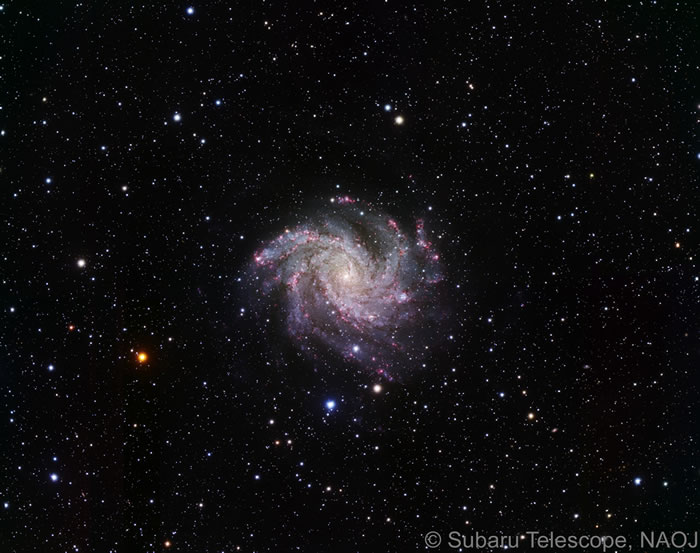Star Formation in Face-on Spiral Galaxy NGC 6946
Astrophotography・

| Object | NGC 6946 (in the constellation Chepheus) | Telescope | The Subaru Telescope |
|---|---|
| Instrument | Suprime-Cam | Wavelengths | Visible Light B (0.45μm), V (0.55μm), IA651 (0.651μm) |
| Exposure | 720 s (B), 540 s (V), 1155 s (IA651) |
| Date | September 3 (B), August 28 (V), August 28 (IA651), 2008 | Observers | Yutaka Komiyama, Ray S. Furuya, Masatoshi Imanishi, 2008 Subaru Observation Experience Program Team |
| Copyright | National Astronomical Observatory of Japan |
This image clearly captures the star forming regions in NGC 6946, a spiral galaxy in the direction of the constellation Chepheus. Because the spiral disk where gas is distributed abundantly and star formation activity is occurring is seen almost directly face on, it is possible to study in detail where and how stars are born in this galaxy. The red color shows locations with strong line emission from hydrogen atoms (Balmer α line), indicating the presence of young, high-temperature stars strongly emitting ionizing ultraviolet (UV) radiation. These kinds of areas were found not just in the spiral but also very outer part of the galaxy as well. On the outskirts of a galaxy, the gas density is very low, so naturally we would expect it to be difficult for new stars to form. The Subaru Telescope’s high-sensitivity, wide-field-of-view, visible-light observations found signs that new stars are being born. Recently this has been a field of active research.
Researching the Mode of Star Formation in remote regions said to be “Outside” of the Spiral Galaxy
Our research into this topic with the Subaru Telescope started from a surprising discovery by NASA’s UV observations satellite GALEX (Galaxy Evolution Explorer). It was found by observing nearby galaxies like NGC 6946 that UV continuum was being emitted from regions ‘outside’ what had up until then appeared to be the edges of the galaxies in optical telescope observations. We immediately knew that the UV emission was a sign of some kind of star formation activity. But in this outer region, there is very little gas from which the stars could form. We thought that there must be a previously unknown mode of star formation occurring. Many researchers thought it would be particularly difficult for high mass stars to form.
But against all expectations, the Subaru Telescope’s high sensitivity observations detected large amounts of spectral line emission from hydrogen gas which had been ionized by the UV radiation from high mass stars. If you look closely at the dark void extending around the periphery of the galaxy in this picture, you can see the emission. In other words, massive stars must be being formed even in the low density regions said to be ‘outside’ of the galaxy. Somehow, the sparse gas is being collected efficiently to form high mass stars. This research continues to be surprising. These results are thought to be an important clue for understanding how stars are formed in a galaxy.
Text by: Masatoshi Imanishi (NAOJ, Subaru Telescope)
With Assistance by: Jin Koda (Stony Brook University)
Translation by: Ramsey Lundock (NAOJ)